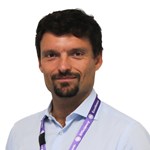Contact us to arrange an arthroscopy
It's easy to find out more about treatment by giving us a call or completing our enquiry form.
Steve had his knee arthroscopy after suffering from painful, debilitating symptoms. Listen to his story and patient journey at our private hospital.
Hi, my name is Steve Perry. I'm a carpenter by trade. I had keyhole surgery on my right knee due to, obviously, my carpentry trade because I've been a member with Benenden for nearly 20 years now. I was 17 when I joined Benenden. I'm nearly 40 now. So, I've had previous surgery with Benenden. I live in Ashford, Kent. So, not very far from the hospital itself.
Due to my trade, I'm on and off my knees a predominant amount of time. So I've been suffering with my right knee, arthritic sort of pain, for quite some time. I got referred from my GP to come to Benenden. It was, you know, general well-being of my knee. It was getting difficult to work with my sort of arthritic pain. So I came to Benenden to get that sorted out.
Consultation was in September. I had my surgery on the 10th of December. So it was quite a short time before I was due to have my surgery on the NHS waiting list. I'd waited two years previous to come in in September to get my initial consultation. So yeah, it was a much shorter time coming to get it done privately with Benenden than it was to wait.
I saw Doctor Thakur. From the first consultation that I saw him, he was very, very friendly, spoke to me a lot about the procedure that he was going to carry out. The service from the staff down to my consultation with Dr. Thakur, genuinely, it was great. You know, the service here, the hospital, the facilities are second to none.
Obviously coming privately has been beneficial to me. I was able to get back to work a lot quicker. My recovery time was very quick. They said sort of 4 to 8 weeks and within sort of 3.5 weeks, as you can see, I'm back to work already. So, the well-being of the staff here, the advice that I was given, was definitely beneficial to me from my initial consultation back in September to my operation in December.
I was recommended by Dr. Thakur to have an MRI scan to check my knee to see how, obviously, what was happening basically. I had a tear on the left side of my cartilage and the right side was badly worn. So they recommended that surgery was really the only sort of best option long term for me without having to have my knee replaced.
I remember when I first came here nearly 20 years ago, the facilities have definitely come on leaps and bounds. The surroundings here, it's always quiet. There's hardly many people here when I do come here and you're able to be seen very quickly. They've all got, you know, on-site cafe, you know, the facilities here, if you're able to be seen same day you can get your scans or a CT, MRI all of that's in the house. So it's very sort of beneficial for you to be able to get everything done without having to go to another hospital and come back to here.
Yeah, generally, I couldn't recommend the service enough. I've been able to get back to work very quickly and the recovery time has been very quick for me. So I can't fault it. It's been beneficial for me to come here to have my surgery done. So I've recommended it. I've got plumbers, electricians that are friends of mine. So I've recommended them to come to Benenden. I've got my mum and dad on my membership. I've also just added my wife and my daughter onto my membership. So I've recommended them to family and friends.

Consultant Orthopaedic Trauma Surgeon
Mr Paolo Consigliere's specialities include arthroscopy, tendon operations and treatment for frozen shoulder.

Consultant Orthopaedic Surgeon
Mr Neen's specialities include clavicle surgery, shoulder surgery, elbow surgery and wrist and hand surgery.

Associate Specialist Surgeon
Mr Reddy specialises in total hip and knee replacements, revision joint replacements, ACL reconstruction, and more.

Consultant Orthopaedic Surgeon
Mr Southgate's specialities include foot and ankle conditions - covering sports injuries and more.

Consultant Orthopaedic Surgeon
Mr Thakral's specialties include shoulder arthroscopic surgery, complex joint replacements for arthritis and trauma.
It's easy to find out more about treatment by giving us a call or completing our enquiry form.